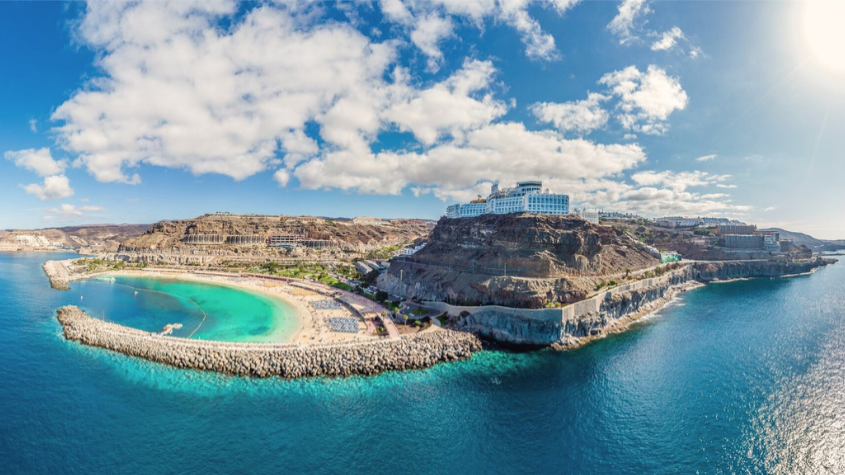
Main Attractions in Gran Canaria, Spain
Known for its golden sandy beaches, impressive mountain scenery and rich cultural heritage, Gran Canaria is a popular tourist destination that captivates visitors from all over the world.
Explore the main attractions in Gran Canaria that promise to bring an unforgettable experience to all who visit the island.
1. Unmissable Natural Attractions
Roque Nublo

The Roque Nublo is one of Gran Canaria's most emblematic landmarks. Located in the centre of the island, this basalt monolith rises imposingly to a height of around 80 metres above the ground. The name "Roque Nublo" derives from the Spanish word "nube", which means "cloud", and refers to the frequent cloud cover that surrounds the top of the mountain.
In addition to its geological importance, the Roque Nublo has great cultural and historical significance for the inhabitants of Gran Canaria. It was considered a sacred place by the indigenous peoples of the Canary Islands, the Guanches, and to this day it is often associated with local legends and traditions.
Maspalomas Dunes

The Maspalomas Dunes are one of Gran Canaria's most famous and distinctive natural attractions. Located on the south coast of the island, these extensive golden sand dunes stretch for around 400 hectares along the coast, creating a stunning and unique landscape.
The dunes were formed over thousands of years by the action of the wind and the tides, and they are constantly changing due to these natural phenomena, which adds even more fascination to their beauty.
One of the highlights of a visit to the Maspalomas Dunes is the opportunity to go camel riding, as well as hiking, bird watching and photography.
Beaches

With over 60 kilometres of coastline, the island offers a variety of beaches to suit all tastes, from busy urban beaches to secluded coves and unspoilt beaches. Playa de Amadores, near Puerto Rico, stands out for its crystal-clear waters and white sand, ideal for relaxing in the sun. Playa de las Canteras, in Las Palmas, is a famous urban beach, three kilometres long, with a variety of activities, such as swimming, surfing and walks. Other options include the lively Playa de Puerto Rico and the remote Playa de Güigüi, with its wild and unspoilt landscape.
Pico de las Nieves

Pico de las Nieves is the highest mountain on the island of Gran Canaria, reaching an altitude of 1,956 metres. This peak offers breathtaking views of almost the whole of Gran Canaria and, on clear days, you can see the neighbouring islands.
The name "Pico de las Nieves" means "Peak of the Snows", because the peak used to be covered in snow during the harsh winters of the past. At the top of the peak, you can find a golf ball, which marks the highest point on the island. There is also a small chapel dedicated to the Virgen de las Nieves, the island's patron saint, where many pilgrims go to seek protection.
As well as the breathtaking views, Pico de las Nieves is a popular spot for hiking and trekking, offering a unique opportunity to explore Gran Canaria's mountainous landscape.
2. Exploring Enogastronomic Culture
Local Wineries

Gran Canaria's local wineries offer a unique opportunity to explore the island's rich winemaking tradition and taste exclusive wines produced in a unique environment. Many of its vineyards are located on volcanic slopes, where the unique soil and climate conditions provide an ideal environment for growing grapes.
One of the most renowned and oldest wineries on the island is the Bodega de los Lírios (1862), located in the Monte Lentiscal region in the north-east of Gran Canaria. In addition to this Bodega, Gran Canaria is home to several other wineries that contribute to the island's rich wine tradition, such as Bodega Bentayga, Bodega Los Berrazales and others.
If you're a wine lover, you can also take Gran Canaria's "wine trails", which are tourist routes that take visitors through the island's wine-growing landscapes, providing opportunities to visit wineries, taste wines and enjoy the natural beauty of the vineyards.
Fresh and Traditional Products

At the heart of the gastronomic experience in Gran Canaria are the fresh, traditional products that can be found in local markets such as the Las Palmas Central Market and the Vegueta Market. Here, you can explore a variety of fresh produce, from exotic tropical fruits to flavoursome local cheeses. The markets are real culinary treasures, where local chefs search for the best ingredients for their creations.
For those who enjoy cooking, you can take cookery classes or workshops to learn how to prepare traditional Canarian dishes such as the famous papas arrugadas, mojo verde and sancocho, immersing yourself in the local gastronomic culture and discovering the secrets behind the island's authentic flavours.
There are also gastronomic events and food festivals, such as the Fiesta del Queso, the Festival de Comida Callejera de Las Palmas, the San Sebastián Festival, among others, which take place throughout the year in Gran Canaria and provide a real celebration of the island's rich gastronomic tradition. The local restaurants are also true ambassadors for Gran Canaria's cuisine, offering an irresistible mix of traditional and contemporary dishes with local and seasonal ingredients.
3. The Main Recreational Attractions
Aqualand Maspalomas

Located in the resort town of Maspalomas, on the south coast of the island, this water park is known for its thrilling water attractions, themed areas and live entertainment. From straight, steep slides to twisty, thrilling turns, there are a variety of options for lovers of aquatic adventures. Ideal for all ages, children or seniors.
Palmitos Park

Located in the lush hills of Maspalomas, this theme park is an oasis of biodiversity where visitors can discover a variety of fascinating flora and fauna.
One of Palmitos Park's main attractions is its tropical birds. In addition to the birds, the park is also home to a variety of other animals and trails and paths through lush botanical gardens.
Poema del Mar Aquarium

The Poema del Mar Aquarium offers visitors the chance to explore fascinating marine ecosystems from all over the world. One of its most striking features is its innovative architectural design, which combines modern, artistic elements with cutting-edge technology. The aquarium is divided into several themed areas, each representing a unique marine ecosystem. In addition to the exhibitions, the Poema del Mar Aquarium offers a variety of interactive and educational experiences for people of all ages.
Sioux city

Located in the San Agustín region, this theme park recreates a typical Old West town, complete with dirt roads, wooden buildings, saloons and even an open-air theatre stage.
The park offers a variety of activities and themed entertainment, including gunfighter duelling shows, country dance performances, pony rides and much more.
4. Authentic and historic places in Gran Canaria
Unmissable neighbourhoods and villages

Exploring Gran Canaria's neighbourhoods and villages is an enchanting way to immerse yourself in the island's culture and history, where each town offers its own unique and authentic atmosphere.
One of the most emblematic neighbourhoods is Vegueta, full of well-preserved colonial buildings, charming squares and narrow streets. Here you can explore the Santa Ana Cathedral, the Casa de Colón Museum and enjoy traditional cafés and restaurants.
One of the most beautiful villages in Gran Canaria is Teror, famous for its centuries-old architecture and the Basilica of Nuestra Señora del Pino, an important pilgrimage site.
A picturesque village known for its stunning scenery and mild climate is Agaete. Visitors can explore the picturesque harbour, enjoy walks through the tropical fruit plantations and relax in the natural hot springs. Then there's Tejeda, situated in the heart of the Gran Canaria mountains, Tejeda is known for its spectacular views and traditional architecture. There are many other places that are equally worth a visit, such as Triana, the Agüimes neighbourhood, among others.
Puerto de Mogán

Puerto de Mogán, known as "the Venice of Gran Canaria", is a picturesque fishing village located on the south-west coast of the island. It is famous for its narrow streets, colourful houses, decorative bridges and navigable canals, which give it a unique charm.
The heart of Puerto de Mogán is its harbour, where traditional fishing boats share space with luxury yachts. In addition to the harbour, Puerto de Mogán offers a beautiful golden sandy beach, surrounded by hills and palm trees.
One of the most popular attractions is its weekly market, which takes place every Friday. This colourful market is a shopper's paradise, offering a variety of local products, handicrafts, clothes and souvenirs.
As we've seen, Gran Canaria is an island rich in history, culture and natural beauty, offering a variety of unmissable attractions for visitors to explore. With its stunning landscapes, rich history and a variety of attractions and activities to suit all tastes, this Spanish island in the heart of the Canary Islands is a place with many things to see. And one that is sure to leave a lasting impression on everyone who visits.
Maybe it's your next holiday destination?
If you want to see other attractions or have other experiences when you visit Gran Canaria, explore the tours, experiences and water activities selected for you.
Visit Living Tours for more travel experiences in Portugal and Spain. And explore more travel ideas on the Living Magazine Blog.
Did you like it?
Average votes: 5.00 of 5
Go Back to the Blog













